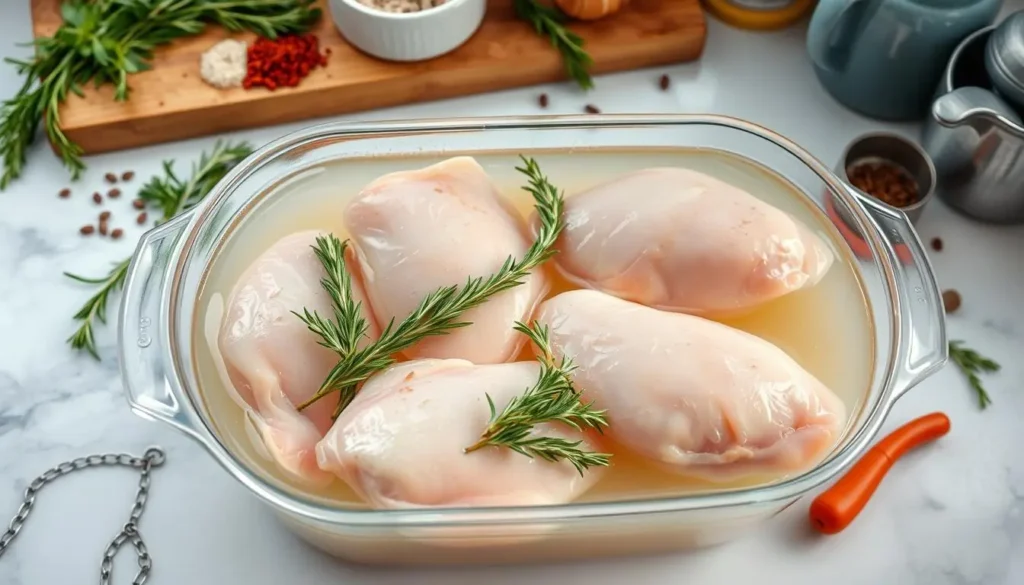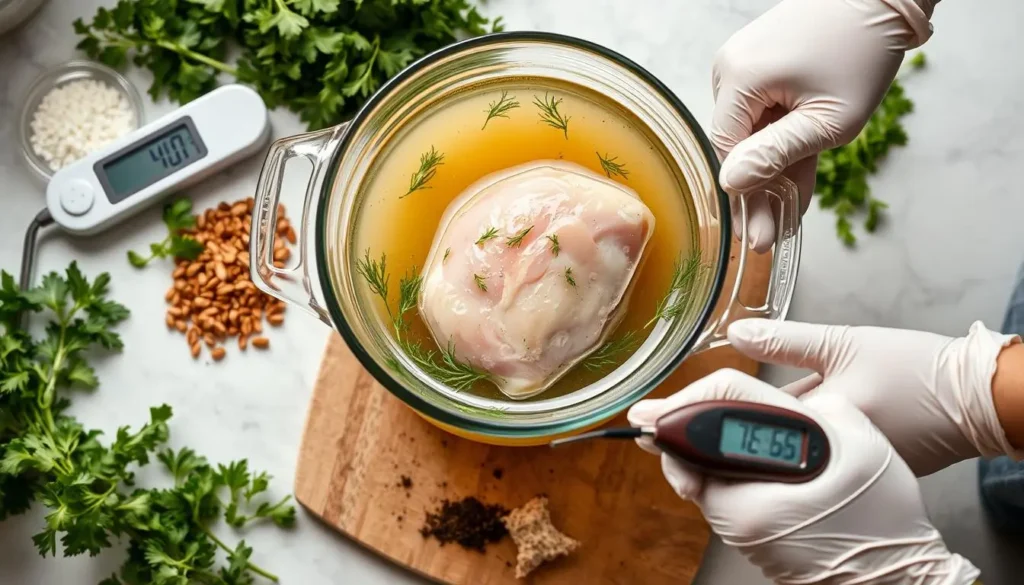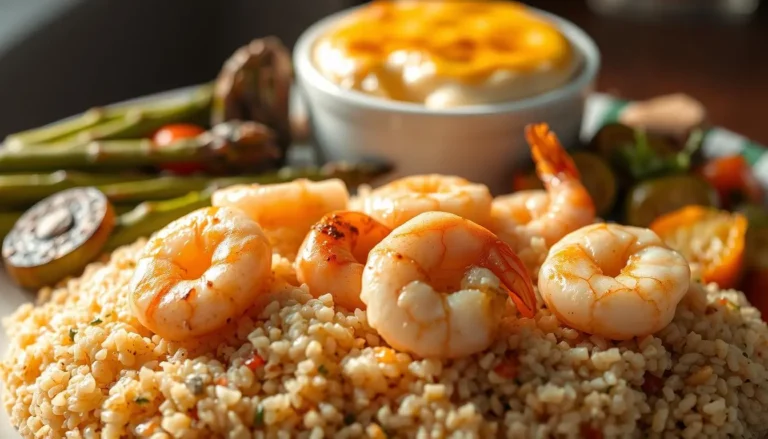How to Brine Chicken Breast for 2X More Tenderness
Learning to brine chicken can boost your cooking skills and open up new flavors. Brining chicken involves soaking it in a saltwater mix to make it tender and flavorful. Knowing the basics of brining can reveal its many benefits, making it a favorite among chefs and home cooks.
To brine chicken, you need to make a brine solution, put the chicken in it, and let it sit for a while.
Brining chicken helps you make tasty and tender dishes that will wow your loved ones. It’s a simple process to learn, and with some practice, you’ll get great at making perfect brines. Whether you want to enhance your chicken’s flavor and texture or just try something new, brining is a great skill to learn.
By adding brining to your cooking, you’ll enjoy its many benefits, making it a key part of many kitchens.
Introduction to Brining
As you dive into brining, you’ll find many techniques and ingredients for the perfect brine. You can play with the salt-to-water ratio and add various seasonings for unique flavors. Learning the basics of brining lets you experiment with different ingredients and methods to create amazing dishes.
Table of Contents
Understanding the Science Behind Brining Chicken
Creating a tasty brine chicken recipe starts with knowing the science. Brining means soaking chicken in a mix of water, salt, and sometimes sugar and spices. This makes the chicken tender and juicy.
To make the best brine for chicken, think about osmosis. Osmosis moves water from areas with more to areas with less solutes. This balances the chicken’s cells, making it tender and flavorful. The right mix of salt and water is key.
Here are some brining chicken tips to remember:
- Use the right ratio of salt to water for a good brine.
- Avoid over-brining to prevent a salty or mushy texture.
- Try different herbs and spices to make your brine chicken recipe unique.
By following these tips and understanding brining, you can make a delicious chicken dish. Whether you’re looking for a simple brine chicken recipe or want to try new flavors, knowing the science is the secret to success.
The Osmosis Process Explained
Osmosis is key in brining, balancing solutes in the chicken’s cells. Knowing how osmosis works helps make a better brine for tender and flavorful chicken.
Why Salt is the Key Player
Salt is crucial in brining, helping to keep moisture and denature proteins. The right amount of salt makes the chicken tender and juicy.
Protein Structure Changes During Brining
Brining changes the chicken’s protein structure, making it more tender and flavorful. Understanding these changes helps create a better brine for delicious chicken.
Essential Ingredients for the Perfect Chicken Brine
Choosing the right ingredients is key to a perfect chicken brine. You can add herbs, spices, and citrus to make a tasty brine. Knowing how each ingredient works with the chicken is important.
Using the right ingredients can make brining faster. The benefits of brining chicken are many. Here are some must-haves for a great brine:
- Salt: It tenderizes the chicken and adds flavor.
- Sugar: It adds sweetness to balance the savory flavors.
- Herbs and spices: Like thyme, rosemary, and garlic, they add depth.
- Citrus: Lemons or oranges add a bright, refreshing taste.
By mixing these ingredients well, you can make a delicious brine. The goal is to find the right mix of flavors. This will make the chicken taste even better.
Brining chicken has many benefits. With the right ingredients, you can make a brine that takes your cooking to the next level.
Basic Chicken Brine Recipe and Ratios
Brining chicken before cooking is a great way to add flavor and moisture. It’s important to have a basic recipe to follow. The salt-to-water ratio in your brine is key. It helps tenderize the chicken and add flavor through osmosis.
Brining chicken tips often stress the need for patience and detail. By following simple guidelines, you can make a delicious, moist chicken dish. The goal is to balance salt, water, and optional flavorings. Herbs, spices, and citrus juice are popular additions.
Salt-to-Water Ratio Guidelines
A good starting point is 1 cup of kosher salt for every 1 gallon of water. You can adjust this to taste. The type of salt used also affects the chicken’s flavor and texture.
Optional Flavoring Additions
Once you have your basic brine, you can try different flavorings. Some ideas include:
- Herbs like thyme, rosemary, or parsley
- Spices like garlic, onion, or paprika
- Citrus juice, such as lemon or orange
These can make your chicken more flavorful. Just make sure not to overpower the chicken’s natural taste.
Temperature Considerations
Temperature is important when brining chicken. Aim for a temperature between 36°F and 40°F. This keeps the chicken safe and prevents bacterial growth. By following these tips, you can make a delicious, moist dish for any occasion.
| Brine Ingredient | Quantity | Purpose |
|---|---|---|
| Salt | 1 cup | Flavor and texture |
| Water | 1 gallon | Moisture and osmosis |
| Optional flavorings | Varying | Enhance flavor |
How to Brine Chicken Step by Step
To get tender and flavorful chicken, learning to brine is key. A good brine recipe can really enhance your chicken’s taste and texture. The process is simple.
Start by making your brine. Mix water, salt, and flavorings like herbs or spices. The right salt-to-water ratio is crucial. You can find many recipes online, but start with a basic one.
After making your brine, soak your chicken in it and chill it. The brining time varies based on chicken type and size, and your flavor preference. Start with a short time and adjust as needed for an easy brine.
Here’s how to brine chicken in basic steps:
- Prepare your brine solution
- Submerge your chicken in the brine
- Refrigerate for the desired amount of time
- Rinse and cook your chicken as desired
By following these steps and using a good recipe, you can make delicious, tender chicken. Whether you’re new to cooking or experienced, learning to brine is a great skill.
| Brine Time | Chicken Type | Flavor Profile |
|---|---|---|
| 30 minutes | Chicken breast | Mild |
| 2 hours | Chicken thighs | Medium |
| 4 hours | Whole chicken | Strong |
Common Mistakes When Brining Chicken
Brining chicken can be tricky. Many people make mistakes that affect the taste and texture. It’s key to know how long to brine and when to start. Too long, and the chicken gets too salty.
Some common mistakes to watch out for include:
- Using the wrong type of salt, which can affect the flavor and texture of the chicken
- Not controlling the temperature, which can impact the safety of the chicken
- Not monitoring the brine chicken time, leading to over-brining or under-brining
To avoid these mistakes, pay close attention to brine chicken time and temperature. Choose the right salt too. This way, you’ll get the best results from brining.
With practice, you’ll master brining chicken. Don’t get discouraged by mistakes. Just learn from them and keep trying. Soon, you’ll enjoy tender, flavorful chicken.
Time Guidelines for Brining Different Cuts
Brining chicken can make it tender and flavorful, but the time needed varies by cut. To brine chicken right, knowing the best brining times for each cut is key. Here’s a guide on how to brine chicken:
For chicken breasts, brine them for 2-4 hours. Thighs and wings need 4-6 hours. Remember, the size and thickness of the meat affect brining time. A bigger breast might need more time than a smaller one.
Here’s a quick guide to brining times for different chicken cuts:
- Chicken breasts: 2-4 hours
- Chicken thighs: 4-6 hours
- Chicken wings: 4-6 hours
- Chicken drumsticks: 4-6 hours
It’s important not to over-brine, as it can make the chicken too salty and mushy. By following these times and tips, you’ll get tender, tasty chicken every time.

Flavor Variations for Your Chicken Brine
Creating the best brine for chicken opens up a world of flavors. You can try different tastes to make a unique brine chicken recipe. Herb-infused brines, for example, bring a fresh and aromatic taste to your chicken.
Herb-Infused Brines
Herb-infused brines add flavor to chicken without being too strong. You can use herbs like thyme, rosemary, or parsley. Just add the herbs to your brine and let it sit for a few hours before adding your chicken.
Citrus-based options also work well, adding a bright and tangy taste. You can use lemons, limes, or oranges for a refreshing brine chicken recipe.
Citrus-Based Options
Citrus-based options are great for adding a bit of acidity. Use citrus juices or zests for a tasty brine chicken recipe. Just add the citrus to your brine and let it sit for a few hours before adding your chicken.
For those who like a bit of heat, spicy brine variations are perfect. You can use spices like cayenne pepper or red pepper flakes for a spicy brine chicken recipe.
Spicy Brine Variations
Spicy brine variations add a kick to your chicken. Use spices or hot sauces for a delicious brine chicken recipe. Just add the spices to your brine and let it sit for a few hours before adding your chicken.
Safety Tips and Food Handling During the Brining Process
When brining chicken, safety is key. Proper handling and storage prevent contamination and illness. To enjoy your cooking safely, follow important guidelines. Brining helps chicken cook evenly, but you must plan the brine time carefully.
Before brining, handle the chicken safely. Wash your hands with soap and warm water before and after touching raw chicken. Keep raw chicken and its juices away from other foods. When brining chicken, store it in the fridge at 40°F (4°C) or below.
Here are some more safety tips:
- Use a food-safe container for brining, big enough for the chicken and brine.
- Keep the brine solution at a consistent fridge temperature to stop bacterial growth.
- Never brine chicken at room temperature, as bacteria can grow fast.

By following these tips, you can enjoy brining chicken safely. Always prioritize safe food handling. If you have questions, check reputable sources about brining.
| Brine Chicken Time | Chicken Cut | Brine Solution |
|---|---|---|
| 30 minutes to 2 hours | Chicken breast | Salt, water, and optional flavorings |
| 2 to 4 hours | Chicken thighs | Salt, water, and optional flavorings |
| 4 to 6 hours | Whole chicken | Salt, water, and optional flavorings |
Cooking Methods for Brined Chicken
Learning how to brine chicken is just the first step. The next is to cook it perfectly. The right brine can greatly affect the taste and texture. You can grill, oven-roast, or pan-sear your chicken for a delicious finish.
Choosing the right cooking method is key. For example, grilling or pan-searing works well with flavorful brines. But, if your brine is simple, oven-roasting might be better.
Grilling Techniques
Grilling adds a smoky taste to brined chicken. Preheat your grill to medium-high. Cook the chicken for 5-7 minutes on each side. Make sure it reaches 165°F inside.
Oven-Roasting Methods
Oven-roasting is a popular choice for cooking brined chicken. Preheat your oven to 425°F. Cook for 20-25 minutes, until it hits 165°F inside.
Pan-Searing Approaches
Pan-searing gives chicken a crispy outside. Heat a skillet over medium-high. Cook for 5-7 minutes on each side, until it’s 165°F inside.
By using these cooking methods and the best brine, you’ll get a tasty, tender chicken. Always cook chicken safely. Enjoy your perfectly cooked brined chicken!
| Cooking Method | Temperature | Cooking Time |
|---|---|---|
| Grilling | Medium-high heat | 5-7 minutes per side |
| Oven-Roasting | 425°F | 20-25 minutes |
| Pan-Searing | Medium-high heat | 5-7 minutes per side |
Conclusion: Mastering the Art of Chicken Brining
Brining chicken is a game-changer that makes chicken tender and flavorful. It’s all about understanding the science and following the right steps. This way, you can impress everyone with your juicy chicken dishes. Brining chicken benefits include tenderness, moisture, and enhanced flavors.
Learning to easy brine chicken takes time and practice. But the results are amazing. Don’t be afraid to try new things and adjust recipes. With each try, you’ll get better and find your own way to brine chicken.
We invite you to share your brining stories and tips with others. Together, we can all get better at making delicious, perfectly brined chicken. Let’s share our knowledge and make every dish unforgettable.
FAQ
What are the benefits of brining chicken?
Brining chicken makes it tender and juicy. It balances the solutes in the chicken’s cells. This results in a more tender and flavorful dish.
How long should I brine chicken?
Brining time varies by chicken cut. Brine breasts for 2-4 hours, thighs and drumsticks for 4-6 hours. Whole chickens need 6-12 hours. Adjust for meat thickness.
What ingredients should I use in my chicken brine?
You’ll need water and salt for a basic brine. Add sugar, herbs, spices, or citrus for flavor. Start with 1/4 cup of salt per gallon of water.
Can I brine chicken before cooking?
Yes, brining before cooking is best. It lets the brine fully penetrate the meat. This makes the chicken juicier and more flavorful.
What are some common mistakes to avoid when brining chicken?
Avoid over-brining and using the wrong salt. Keep the brine at the right temperature. Follow recommended times and ratios for the best results.
What are some flavor variations I can try for my chicken brine?
Try herb-infused, citrus-based, or spicy brines. These add depth and complexity to your chicken dishes.
How should I store brined chicken before cooking?
Pat the chicken dry and store it in a clean container in the fridge. Don’t leave it at room temperature for too long to prevent bacterial growth.
What are the best cooking methods for brined chicken?
You can grill, oven-roast, or pan-sear brined chicken. Each method brings out the chicken’s enhanced tenderness and flavor in its own way.







